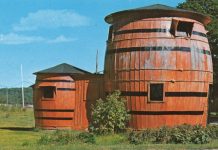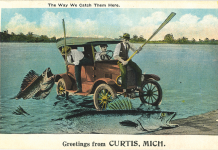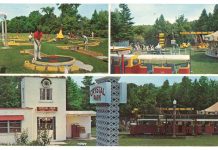
It is generally believed Swedish settlers in Delaware built the first log cabin in America about 1638, followed by German settlers in Pennsylvania in the early 1700s. By the American Revolution, the log cabin had become the most common type of dwelling and a symbol of the frontier.
The tradition of log construction moved to Michigan with the early settlers. Log cabins could be built quickly from the wealth of Michigan timber. The insulation provided by the thick wooden walls kept the dwellings cool in summer and warm in the winter. As mechanized sawmills became widespread, wood-framed construction overtook building with logs.
A log construction revival began with the great camps of the Adirondacks in upstate New York in the 1880s. During the Great Depression of the 1930s, the WPA (Works Progress Administration) and the CCC (Civilian Conservation Corps) built log park lodges, pavilions, bathhouses, rangers stations and lookout towers. These are the kind of log structures we expect to see on the Michigan landscape. But over the years, other log buildings were created with different purposes in mind. There was a log railroad depot at Aloha; a log chapel, Our Lady of the Pines, in Copper Harbor; the log Greyhound Post House in Coldwater, as the name infers, was a bus stop and restaurant; the Ox Yoke Cabin in Prudenville sold souvenirs and gifts; and Ken’s Fishing Supply offered live bait and fishing tackle.

Resorts with log cabins often expanded their services to include restaurants and gasoline pumps. Many of these were built in the 1930s and 1940s. Miller’s Camping Lodge had a small restaurant/grocery store that catered to travelers on US-2 near the Cut River before the highway was rerouted in 1947. The Log Cabin Eat and Drink Shop in Eastport and The Roxie in Houghton Lake were popular stopping places in the 1940s. Hick’s Resort at Long Lake operated a handsome log station in the 1930s. The Shrine of the Pines Trading Post in Baldwin offered gasoline and sundries, along with rental cabins in the 1930s. A few motels, like the M-37 Motel near Baldwin, were built with logs, beckoning travelers with the suggestion of a rustic retreat.
An outstanding log restaurant, Mount Shasta, was built in the 1930s in Ishpeming and relocated to Michigamme in 1939. It was taken apart log by log, with each log numbered, then shipped and reassembled at its location on US-41. Mount Shasta’s unique log scenic setting was chosen for the 1959 film, “Anatomy of a Murder.” The classic scene with Jimmy Stewart and Duke Ellington playing the piano was shot at Mount Shasta. Unfortunately, the restaurant closed in 2015.
Log cabins could be built quickly from the wealth of Michigan timber. The insulation provided by the thick wooden walls kept the dwellings cool in summer and
warm in the winter.
The Trading Post in Standish was a stop for many northbound travelers on the newly paved US-23 when it opened in 1931. The log building was modeled after an old Canadian Hudson Bay Company trading post and cost somewhere between $35,000 and $40,000 to build. The establishment comprised of a “Good Eats” restaurant, rental cabins, filling station, sporting goods store and fish market. It burned in 1972 and was rebuilt without its trademark logs.
The Graceland Ballroom in Lupton was built in the 1920s at the cost of $40,000. The massive structure built of pine and Norway spruce was reputed to be a speakeasy for the infamous “Purple Gang” of Detroit during prohibition. It also served as a “hideout” when life in Detroit became too dicey for gang members. Its colorful past was promoted in the 1960s and 1970s to increase business before a fire destroyed the historic building in 1981.

“Anatomy of a Murder.” // Photography courtesy of Vintage Views
One of the most remarkable log structures is the Pines Theatre in Houghton Lake, completed in 1941. The “showplace of the north” was designed by C. Howard Crane in a hunter’s chalet style and constructed of pine and tamarack logs. Crane also was the architect of the Fox Theatre in Detroit, along with several other Michigan theaters. The building was restored in 1973 and still operates today in all its log splendor.
Log construction has not lost its charm since the days of the pioneers. The log cabin was rediscovered during the 1960s and 1970s with the back-to-nature movement and spread to the general population in the 1980s and endures today. Distinctive log architectural gems continue to draw our attention as we drive along Michigan’s roads and highways.
BLUE Vintage Views columnists M. Christine Byron and Thomas R. Wilson reside in Grand Rapids. Their five Vintage Views pictorial books have received three Michigan Notable Book awards and a State History Award.







Facebook Comments